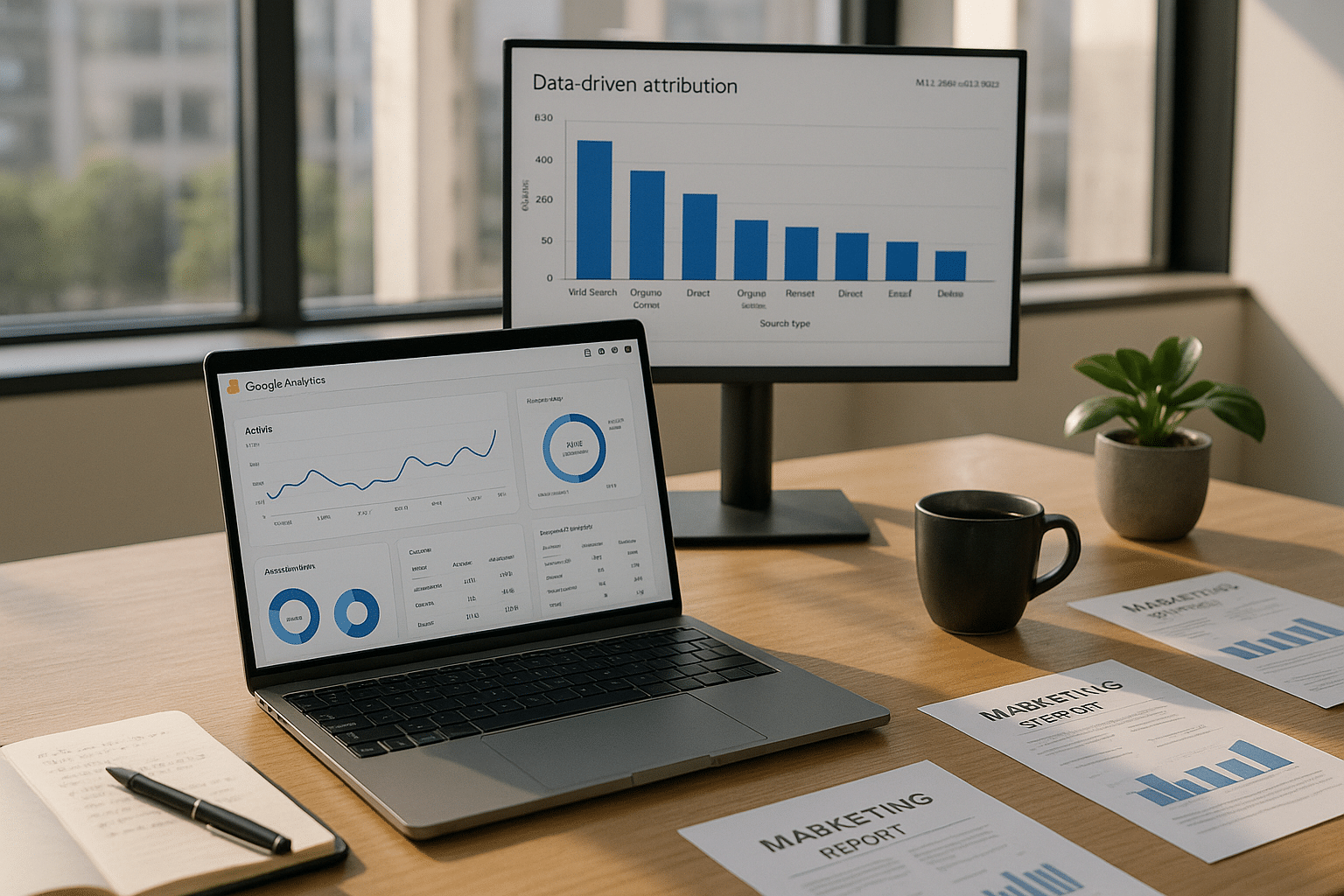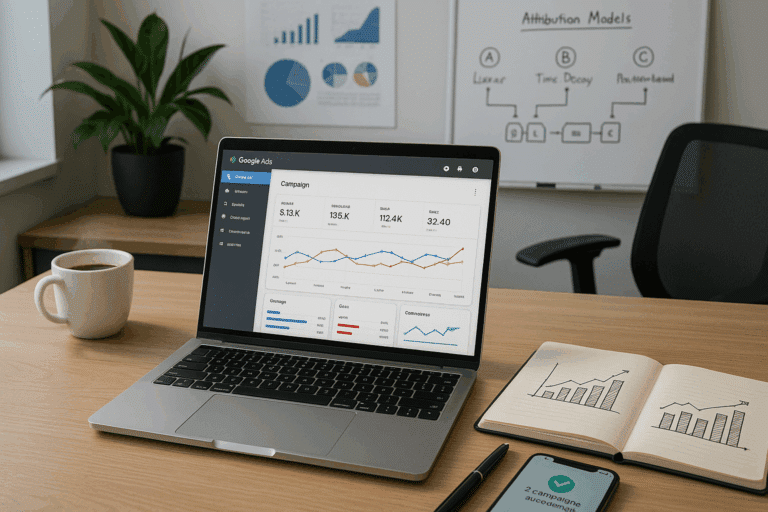To the untrained eye, this data may appear as an overwhelming cluster of numbers and metrics, but for the discerning marketer, it’s a gold mine of insights, ready to be harnessed. When understood and interpreted correctly, this data can unveil information about your customers’ behavior, preferences, and the effectiveness of your marketing efforts. 👀📊
In a world where we’re inundated with different marketing channels, understanding how each one performs and contributes to your overall marketing success can be a challenging task. But, what if there was a way to navigate this complex web of metrics, and attribute your marketing success to specific channels? This is where the power of data-driven attribution (DDA) in Google Analytics 4 (GA4) comes into play. 🕸️🔍
Why Data-Driven Attribution is Your North Star 🌟
Attribution is an essential concept in digital marketing, as it empowers businesses to understand which marketing touchpoints are driving conversions and which ones may require optimization. The focus of this blog post is to demystify the concept of data-driven attribution and elucidate how it can be leveraged in GA4 to maximize your marketing impact. 📈💰
Data-driven attribution is a game-changer, providing marketers with the ability to assign credit to the marketing touchpoints along the conversion paths that have proven to be the most effective. Unlike other attribution models that distribute credit equally among all touchpoints, DDA uses machine learning to analyze your conversion data and determine how much credit each touchpoint deserves. In essence, DDA in GA4 is the key to unlocking the power of your marketing data. 🔐🚀
Navigating the GA4 Landscape 🧭
Google Analytics 4, the latest iteration of Google’s widely used web analytics service, is designed to provide more insightful and actionable data. GA4 is different from its predecessor in many ways, but perhaps its most remarkable feature is its robust data-driven attribution capabilities. This blog post will delve into the nuances of using DDA in GA4, providing a comprehensive guide to help you understand and effectively utilize this feature. 🗺️📘
We will explore a range of topics, including how to set up DDA in GA4, understanding and interpreting DDA reports, and tips for using DDA to make informed marketing decisions. Additionally, we will discuss the advantages and potential challenges of using DDA in GA4, and provide recommendations for effectively integrating DDA into your overall marketing strategy. 📝🔧
With the power of data-driven attribution in GA4 at your fingertips, the daunting task of navigating the vast sea of marketing data becomes significantly easier. The possibilities are truly endless, and with the right approach, the benefits are substantial. So, are you ready to dive in and harness the power of data-driven attribution in GA4 to maximize your marketing impact? Let’s get started! 🌊⚡
Embracing Data-Driven Attribution with GA4: Transform Your Marketing Impact
Within the realm of digital marketing, utilizing data-driven attribution can be a game-changer for businesses. It provides essential insights and in-depth analysis that empower marketers to make informed decisions based on real data, thereby maximizing the marketing impact. With Google Analytics 4 (GA4), harnessing the power of data-driven attribution has become easier and more efficient than ever. But what exactly is data-driven attribution, and how can it be harnessed in GA4? Let’s delve into this in-depth.
Data-driven attribution is a modeling algorithm that uses machine learning to determine how much credit for a conversion each touchpoint in a conversion path deserves. It provides a more accurate reflection of the value of different marketing channels and campaigns, allowing marketers to optimize their budget allocation and strategy.
GA4, the latest iteration of Google Analytics, has brought significant changes to the platform, including improved attribution modeling capabilities. The platform uses machine learning to understand and predict consumer behavior, offering more granular data and allowing for better decision-making. As such, it’s an ideal tool for implementing data-driven attribution.
Data-Driven Attribution vs. Traditional Attribution Models
To truly appreciate the benefits of data-driven attribution in GA4, it’s important to understand how it compares to traditional attribution models. Here’s a comparative analysis:
| Data-Driven Attribution | Traditional Attribution Models | |
|---|---|---|
| Methodology | Uses machine learning to determine the value of each touchpoint | Assigns credit based on a predetermined rule |
| Accuracy | More accurate as it considers all touchpoints | Less accurate as it may overlook certain touchpoints |
| Flexibility | Adapts to changes in consumer behavior | Static and does not adapt to changes |
As the table illustrates, data-driven attribution offers a more accurate and flexible approach to understanding marketing performance compared to traditional attribution models. For an in-depth comparison, check out the video “Data-Driven Attribution vs. Traditional Models” by MeasureSchool on YouTube.
Navigating GA4 for Data-Driven Attribution: A Comprehensive Guide
Now that we’ve covered the basics of data-driven attribution and how it compares to traditional models, it’s time to explore how to implement this approach using GA4. Let’s walk through a step-by-step guide.
Setting Up GA4 for Data-Driven Attribution
The first step in harnessing the power of data-driven attribution in GA4 is setting up the platform correctly. This involves creating a new property, configuring data streams, and setting up conversion events. Once these are set up, GA4 will start collecting data which can be used for data-driven attribution.
For a comprehensive guide on how to set up GA4, watch the YouTube video “Google Analytics 4 (GA4) Setup Guide” by MeasureSchool. It provides a step-by-step walkthrough, ensuring you make the most of the platform’s capabilities.
Understanding the Attribution Report in GA4
Once you’ve set up GA4, you can dive into the Attribution report. This report offers insights into the conversion paths of your users, showing which touchpoints contribute to conversions and how much credit each touchpoint deserves. You can customize the report to suit your needs, choosing from different attribution models, conversion types, and lookback windows.
The Attribution report in GA4 is a powerful tool for understanding your marketing performance. It offers valuable insights that can guide your marketing strategy, helping you optimize your budget allocation and increase your return on investment (ROI).
Maximizing Your Marketing Impact with GA4: Practical Tips
GA4 offers a wealth of opportunities for enhancing your marketing strategy through data-driven attribution. Here are some practical tips to maximize your marketing impact using GA4.
Leveraging Custom Funnels
One of the key features of GA4 is the ability to create custom funnels. These funnels allow you to visualize the user journey, helping you understand where users drop off and where they convert. By understanding these funnels, you can optimize your marketing strategy, focusing on touchpoints that drive conversions and improving those that don’t.
Optimizing for Mobile
With GA4, you can gain deeper insights into your mobile performance. The platform offers specific reports for mobile app data, allowing you to understand how users interact with your app. By optimizing your mobile strategy based on these insights, you can enhance user experience, drive more conversions, and maximize your marketing impact.
Benefiting from Predictive Metrics
GA4 uses machine learning to predict future user behavior, offering predictive metrics such as Purchase Probability and Churn Probability. These metrics can inform your marketing strategy, helping you target users who are likely to convert and retain those at risk of churning.
With these practical tips, you can harness the power of data-driven attribution in GA4 to maximize your marketing impact. For a comprehensive guide on using GA4, watch the YouTube video “Mastering Google Analytics 4” by MeasureSchool.

Conclusion
As we conclude this comprehensive guide on software development methodologies, it is crucial to remember the central themes we’ve discussed. As a review, we examined a multitude of development strategies, each with their unique traits and uses, from Waterfall and Agile to DevOps and Scrum. We delved deep into the intricate details of each, making sure to highlight the benefits and potential challenges.
Recognizing the appropriate methodology for your specific project is vital. Remember, there’s no one-size-fits-all solution. Each methodology comes with its own unique set of principles, goals, and processes. Whether it’s the sequential design process of Waterfall, the flexibility of Agile, or the efficiency of DevOps, choosing the right method can impact the efficiency and success of your software development project.
Let’s not forget the importance of understanding your team’s capabilities and the project’s complexity. These factors play a significant role in determining the most suitable method. The key is to adopt a methodology that allows your team to work effectively, driving productivity and innovation.
As we have seen, the software development world is constantly evolving. So, it’s crucial to stay updated on the latest methodologies and trends. Continued learning and adaptability are keys to remaining relevant and successful in this fast-paced field.
If this article has sparked your interest or you have further insights to share, I encourage you to leave a comment below. Sharing your experiences and thoughts not only enriches your knowledge but also contributes to a broader understanding of the subject for all readers. Plus, who knows? Your comment could be the missing puzzle piece for someone else’s challenge. 🚀
Don’t forget to share this guide with your networks on LinkedIn, Facebook, or Twitter. Let’s promote a culture of knowledge sharing. You never know whose day you might brighten with new knowledge, or whose project you might save. 💡
Lastly, if you found this article helpful and want to apply what you’ve learned, remember to practice. Experiment with different methodologies on smaller projects and see what works best for your team and project requirements.
With that, I’d like to thank you for sticking with me until the end of this detailed exploration. I sincerely hope that you found the information valuable, and that it helps steer you in the right direction in your software development journey.
For further reading on software development methodologies, consider checking these links from reputable sources:
– [Agile methodology guide](#)
– [Understanding DevOps](#)
– [An in-depth look at Scrum](#)
Feel free to explore, learn, and contribute to the never-ending journey of software development. Let’s continue to build and innovate for a better future. 🔭🌠
Happy Coding!
[end]
Please note that all HTML tags included in this text are valid WordPress tags. However, always ensure to replace the ‘#’ in the href attribute with the actual URL of the resources you’re linking to.



